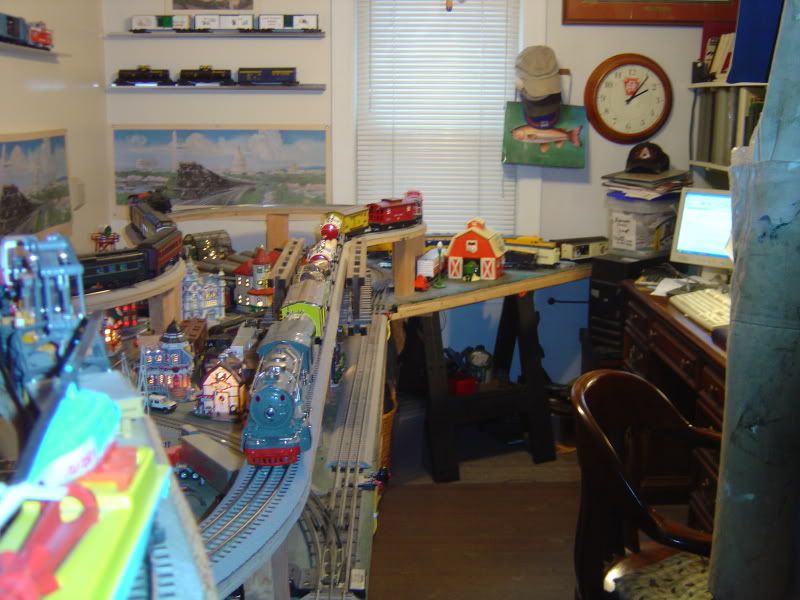Trying to learn all I can about electricity to hook up DCS, (soon Legacy), turnouts, accessories, toggle switches, etc. But still have some noob questions (will probably have a few more as I go along) - would appreciate any help:
- Is 3-rail DC or AC? I'm under the impression that it's DC but can't seem to confirm.
- For purposes of DCS, I'm star pattern wiring track. I hooked up my first turnout (Atlas O No. 5). It will be wired to a separate power source and not thru TIU. I did power drops at all 3 legs and screwed wires into a Home Depot terminal block, but didn't connect the terminal block to the buss yet - so it is not connected to electricity yet. When I flipped on my Z4K (testing my trackwork on both sides of turnout), it tripped. Determined that having the power drops screwed to the unpowered HD block was the cause. I disconnected the power drops from the HD block and everything was fine. Why? Now concerned that if I add re-connect those power drops to the block and power it, I might go up in flames.
- For turnouts and accessories, I will be using a 16 gauge (or should I use 14 AWG?) buss wire. I have the OGR stranded that comes with an outer gray sheath. Do others keep the hot/common in the outer sheathing and just make openings where they need to connect things (for neatness)? Or completely take off outer sheathing?
- Should I connect the buss wire to the accessory port, or to a port with more power? I will have approx 3 - 5 turnouts on each loop and a normal amount of accessories (for a 14 x 33 foot layout).
- Should the hot and common buss wires each make a complete loop? Meaning, should the wires make a big circle - both ends of each wire terminating at the same spot they originated - the same hot or common port? Or should only one end be connected to the respective port?
Thanks very much - really appreciate it. Don't know anyone in my area that is in our hobby, so you guys are invaluable.
Peter



![IMG_1120[1] IMG_1120[1]](https://ogrforum.com/fileSendAction/fcType/0/fcOid/14804764829157753/filePointer/14804764834478787/fodoid/14804764834478778/imageType/MEDIUM/inlineImage/true/IMG_1120%255B1%255D.jpg)
![IMG_1126[1] IMG_1126[1]](https://ogrforum.com/fileSendAction/fcType/0/fcOid/14804764829157753/filePointer/14804764834478788/fodoid/14804764834478779/imageType/MEDIUM/inlineImage/true/IMG_1126%255B1%255D.jpg)
![IMG_1123[1] IMG_1123[1]](https://ogrforum.com/fileSendAction/fcType/0/fcOid/14804764829157753/filePointer/14804764834478789/fodoid/14804764834478780/imageType/MEDIUM/inlineImage/true/IMG_1123%255B1%255D.jpg)
![IMG_1122[1] IMG_1122[1]](https://ogrforum.com/fileSendAction/fcType/0/fcOid/14804764829157753/filePointer/14804764834478790/fodoid/14804764834478781/imageType/MEDIUM/inlineImage/true/IMG_1122%255B1%255D.jpg)
![IMG_1124[1] IMG_1124[1]](https://ogrforum.com/fileSendAction/fcType/0/fcOid/14804764829157753/filePointer/14804764834478791/fodoid/14804764834478782/imageType/MEDIUM/inlineImage/true/IMG_1124%255B1%255D.jpg)
![IMG_1125[1] IMG_1125[1]](https://ogrforum.com/fileSendAction/fcType/0/fcOid/14804764829157753/filePointer/14804764834478792/fodoid/14804764834478783/imageType/MEDIUM/inlineImage/true/IMG_1125%255B1%255D.jpg)
![IMG_1126[1] IMG_1126[1]](https://ogrforum.com/fileSendAction/fcType/0/fcOid/14804764829157753/filePointer/14804764834478788/fodoid/14804764834478779/imageType/SQUARE_THUMBNAIL/inlineImage/true/IMG_1126%5B1%5D.jpg)
![IMG_1123[1] IMG_1123[1]](https://ogrforum.com/fileSendAction/fcType/0/fcOid/14804764829157753/filePointer/14804764834478789/fodoid/14804764834478780/imageType/SQUARE_THUMBNAIL/inlineImage/true/IMG_1123%5B1%5D.jpg)
![IMG_1122[1] IMG_1122[1]](https://ogrforum.com/fileSendAction/fcType/0/fcOid/14804764829157753/filePointer/14804764834478790/fodoid/14804764834478781/imageType/SQUARE_THUMBNAIL/inlineImage/true/IMG_1122%5B1%5D.jpg)
![IMG_1124[1] IMG_1124[1]](https://ogrforum.com/fileSendAction/fcType/0/fcOid/14804764829157753/filePointer/14804764834478791/fodoid/14804764834478782/imageType/SQUARE_THUMBNAIL/inlineImage/true/IMG_1124%5B1%5D.jpg)
![IMG_1125[1] IMG_1125[1]](https://ogrforum.com/fileSendAction/fcType/0/fcOid/14804764829157753/filePointer/14804764834478792/fodoid/14804764834478783/imageType/SQUARE_THUMBNAIL/inlineImage/true/IMG_1125%5B1%5D.jpg)




